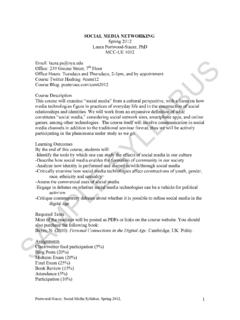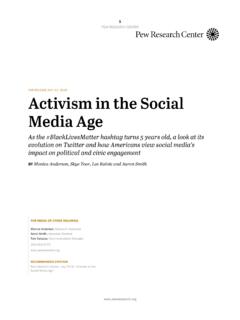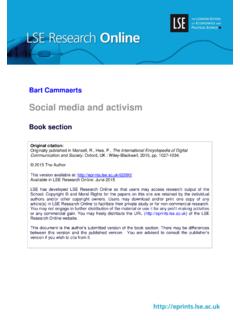Transcription of Can social media effectively include women’s voices in ...
1 can social media effectively include women s voices in decision-making processes? OECD Development Centre, March 2015 The opinions expressed and arguments employed herein are the sole responsibility of the authors and do not necessarily reflect those of the OECD or of the governments of its member countries. by Estelle Loiseau and Keiko Nowacka Key messages social media has proven potential for mobilising attention and accountability to women s rights, and challenging discrimination and stereotypes.
2 Obstacles remain in translating women s online advocacy to pushing for systemic change through policy. Strategies to enhance social media s potential for women s empowerment include facilitating their access to technology; increasing women s representation in public life and media ; and working with a cross-section of actors. social media has proved to be a powerful vehicle for bringing women s rights issues to the attention of a wider public, galvanising action on the streets of cities around the world and encouraging policy makers to step up commitments to gender equality.
3 Recent cases in Turkey and India reflect the potential of social media to bridge the gap that often separates grassroots women s activism from policy-making processes. The explosion of social media and unprecedented use by women of new technologies represents important opportunities to bring gender equality and women s rights issues to the forefront of both policy making and media attention. In 1995, the Beijing Platform for Action recognised and predicted the media s potential to make a far greater contribution to the advancement of women (para.)
4 234). This call has been echoed in the proposed targets under Goal 5 of the post-2015 Sustainable Development Goals (SDGs). Like in 1995, challenges remain in utilising media to combat discrimination, counter gender stereotypes and raise awareness of women s rights issues. While globally, women are greater users of social media than men (McPherson, 2014), many women , especially in developing countries, still do not have access to this technology due to infrastructure, costs and discriminatory social norms (ICRW, 2010).
5 This briefing note examines the extent to which social media can be an effective lever to amplify women s voices and identify strategies to better facilitate their impact on decision-making processes. Over the past seven years, the OECD Development Centre s Wikigender platform1 has been engaging with a cross-section of gender equality actors, from civil society to governments, as a means of promoting women s voices in policy-making fora. This note will present key arguments shared during a recent Wikigender online discussion on Advancing women s rights through social media : which strategies?
6 2 It will review successful social media campaigns, analyse current obstacles, and conclude with recommendations on how social media can effectively broaden the scope for action on women s rights and gender equality within a post-2015 agenda. 1 Wikigender is a web platform to share and exchange knowledge on gender equality and women s rights, see 2 The discussion Advancing women s rights through social media : which strategies? took place from 11-20 February 2015.
7 See to read the contributions. 2 Issues Paper: can social media effectively include women s voices in decision-making processes? OECD 2015 1. The social media revolution and women s empowerment social media has transformed the landscape of how information is shared globally and the relationship between citizens and governments (Shirky, 2011). Beyond its use as a social networking tool, social media allows for the first time any individual to share content and opinions to a global audience, bypassing traditional media or other modes of information transmission (European Parliament, 2013).
8 Platforms such as YouTube, Facebook or Twitter have allowed activists around the world to retransmit events live to a broad online audience, such as during the Arab Spring movement (Pew Research Center, 2012). Local issues become global concerns; local activists become connected with global citizens. women s rights movements have also been quick to capitalise on social media s unprecedented political and awareness-raising potential. During the Wikigender online discussion, participants stressed the importance of social media in allowing gender activists to connect within and across borders, at a low cost.
9 The surge of female bloggers has in particular helped attract a younger generation of activists, who represent a key target audience to break established stereotypes and help advance gender equality. Below are three areas identified by the Wikigender online discussion and research where social media has enabled women s political activism : Hashtag activism bringing women s issues to the forefront of political agendas: Hashtag activism has helped to mobilise public attention on women s rights, increasing the visibility of issues that are under-reported in mainstream media .
10 For example in 2013, the #BringBackOurGirls campaign reached over 1 million tweets, helping to raise awareness of both national and international actors of the need to help rescue the abducted Nigerian schoolgirls (Tomchak, 2014). Before the hashtag campaign s success, the case received little media attention (Dewey, 2014). UN women s successful and high-profile #HeFor She campaign further highlights the potential of social media to attract new and larger audiences: the campaign engaged with more than billion people, putting the global spotlight on the need to engage men and boys to achieve gender equality.



















